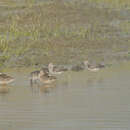en
names in breadcrumbs


Named for its long, thin legs, the Stilt Sandpiper (8 1/2 inches) appears to most North American birders as a grayish wader with a white breast, light gray neck, and long white eye-stripes. However, this species’ breeding plumage gives it a brown-scalloped breast and rusty-red cheek patch. In all plumages, the Stilt Sandpiper may be separated from other related species by its tall stature. Males and females are similar at all seasons. The Stilt Sandpiper winters locally along the arctic coast of North America from the Hudson Bay to northern Alaska. This species is a long-distance migrant, wintering primarily in south-central South America. However, smaller wintering populations exist further north, including in central Mexico, along the western Gulf coast, and locally in Florida and South Carolina. The Stilt Sandpiper breeds on wet tundra. On migration and during the winter, this species may be found along the edges of ponds and in shallow coastal lagoons and mudflats. Stilt Sandpipers primarily consume small invertebrates, particularly insects and larvae. Due to its remote breeding habitat, most birdwatchers never see the Stilt Sandpiper during the summer. On migration or during the winter, this species may be seen probing the mud for food with its bill while wading in shallow water. The Stilt Sandpiper is primarily active during the day.
Named for its long, thin legs, the Stilt Sandpiper (8 1/2 inches) appears to most North American birders as a grayish wader with a white breast, light gray neck, and long white eye-stripes. However, this species’ breeding plumage gives it a brown-scalloped breast and rusty-red cheek patch. In all plumages, the Stilt Sandpiper may be separated from other related species by its tall stature. Males and females are similar at all seasons. The Stilt Sandpiper winters locally along the arctic coast of North America from the Hudson Bay to northern Alaska. This species is a long-distance migrant, wintering primarily in south-central South America. However, smaller wintering populations exist further north, including in central Mexico, along the western Gulf coast, and locally in Florida and South Carolina. The Stilt Sandpiper breeds on wet tundra. On migration and during the winter, this species may be found along the edges of ponds and in shallow coastal lagoons and mudflats. Stilt Sandpipers primarily consume small invertebrates, particularly insects and larvae. Due to its remote breeding habitat, most birdwatchers never see the Stilt Sandpiper during the summer. On migration or during the winter, this species may be seen probing the mud for food with its bill while wading in shallow water. The Stilt Sandpiper is primarily active during the day.
The stilt sandpiper (Calidris himantopus) is a small shorebird. The scientific name is from Ancient Greek. The genus name kalidris or skalidris is a term used by Aristotle for some grey-coloured waterside birds. The specific himantopus means "strap foot" or "thong foot".[2]
This sandpiper bears some resemblance to the smaller calidrid sandpipers or "stints". DNA sequence information is incapable of determining whether it should be placed in Calidris or in the monotypic genus Micropalama.[3] It appears most closely allied with the curlew sandpiper,[4] which is another aberrant species only tentatively placed in Calidris and could conceivably be separated with it in Erolia.
The stilt sandpiper breeds in the open arctic tundra of North America. It is a long-distance migrant, wintering mainly in northern South America. It occurs as a rare vagrant in western Europe, Japan and northern Australia.[5]
This species nests on the ground, laying three or four eggs. The male has a display flight. Outside the breeding season, this bird is normally found on inland waters, rather than open coasts.

This species resembles the curlew sandpiper in its curved bill, long neck, pale supercilium and white rump. It is readily distinguished from that species by its much longer and paler legs, which give rise to its common and scientific names. It also lacks an obvious wing bar in flight. Breeding adults are distinctive, heavily barred beneath, and with reddish patches above and below the supercilium. The back is brown with darker feather centres. Winter plumage is basically gray above and white below. Juvenile stilt sandpipers resemble the adults in their strong head pattern and brownish back, but they are not barred below, and show white fringes on the back feathering.
Measurements:
These birds forage on muddy, picking up food by sight, often jabbing like the dowitchers with which they often associate. They mainly eat insects, other invertebrates (such as molluscs), seeds, and the leaves and roots of aquatic plants.[8]
The stilt sandpiper (Calidris himantopus) is a small shorebird. The scientific name is from Ancient Greek. The genus name kalidris or skalidris is a term used by Aristotle for some grey-coloured waterside birds. The specific himantopus means "strap foot" or "thong foot".